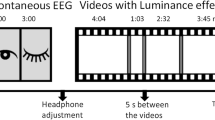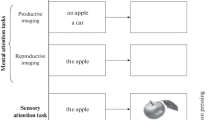We investigated the relations between EEG activity and sustained attention in humans. A visual version of the conjunctive continuous performance task (CCPT-V) was used as a measure of sustained attention. Twenty university students voluntarily participated in the study; they were divided into two groups, good and weak, according to their results in the CCPT-V. The spectral power of EEG recorded from Fz, Cz, and Pz was analyzed under three conditions (eyes open, eyes closed, and CCPT-V) in four frequency ranges, theta (4–8 Hz), alpha (8–13 Hz), beta (13–30 Hz) and gamma (30–60 Hz) in three channels. Results of repeatedmeasures MANOVA showed the significance of the effects of conditions and channels with respect to the alpha and theta but not to the beta and gamma powers. There was no significant effect of the group, but, when comparing the alpha power under three conditions, the good group showed lower spectral powers. It has been concluded that cerebral neuronal systems producing alpha and theta oscillations play a role in sustained attention, and this can be shown by EEG recording and in the respective test.
Similar content being viewed by others
References
W. Singer, “Synchronization of cortical activity and its putative role in information processing and learning,” Ann. Rev. Physiol., 55, No. 1, 349-374 (1993).
W. Singer and C. M. Gray, “Visual feature integration and the temporal correlation hypothesis,” Ann. Rev. Neurosci., 18, No. 1, 555-586 (1995).
M. Gola, M. Magnuski, I. Szumska, and A. Wróbel, “EEG beta band activity is related to attention and attentional deficits in the visual performance of elderly subjects,” Int. J. Psychophysiol., 89, No. 3, 334-341 (2013).
K. Schweizer and H. Moosbrugger, “Attention and working memory as predictors of intelligence,” Intelligence, 32, No. 4, 329-347 (2004).
L. Stankov, R. Roberts, and G. Spilsbury, “Attention and speed of test-taking in intelligence and aging,” Pers. Individ. Differ., 17, No. 2, 273-284 (1994).
K. Ball, “Attentional problems and older drivers,” Alzheimer Dis. Ass. Disord., 11, 42-47 (1997).
M. A. Reger, R. K. Welsh, G. Watson, et al., “The relationship between neuropsychological functioning and driving ability in dementia: a meta-analysis,” Neuropsychology, 18, No. 1, 85 (2004).
N. Lincoln and K. Radford, “Cognitive abilities as predictors of safety to drive in people with multiple sclerosis,” Mult. Scler., 14, No. 1, 123-128 (2007).
M. I. Posner, “Attention: the mechanisms of consciousness,” Proc. Natl. Acad. Sci., 91, No. 16, 7398- 7403 (1994).
N. Cowan, Attention and Memory, Oxford Univ. Press, Oxford (1997).
R. J. Sternberg, Cognitive Psychology, Wadsworth, Australia (2006).
M. M. Sohlberg and C. A. Mateer, “Effectiveness of an attention-training program,” J. Clin. Exp. Neuropsychol., 9, No. 2, 117-130 (1987).
M. M. Sohlberg and C. A. Mateer, “Theory and remediation of attention disorders,” in: Introduction to Cognitive Rehabilitation, Theory and Practice, Guilford Press, New York (1989).
M. Sarter, B. Givens, and J. P. Bruno, “The cognitive neuroscience of sustained attention: where top-down meets bottom-up,” Brain Res. Rev., 35, No. 2, 146-160 (2001).
L. Shalev, A. B. Simon, C. Mevorach, et al., “Conjunctive Continuous Performance Task (CCPT) – A pure measure of sustained attention,” Neuropsychologia, 49, No. 9, 2584-2591 (2011).
F. Ghassemi, M. H. Moradi, M. T. Doust, and V. Abootalebi, “Classification of sustained attention level based on morphological features of EEG’s independent components,” in: Complex Medical Engineering, Proc. ICME Int. Conf. (IEEE) (2009).
A. Achim, J. Bouchard, and C. M. Braun, “EEG amplitude spectra before near-threshold visual presentations differentially predict detection/omission and short–long reaction time outcomes,” Int. J. Psychophysiol., 89, No. 1, 88-98 (2013).
J. R. Wang and S. Hsieh, “Neurofeedback training improves attention and working memory performance,” Clin. Neurophysiol., 124, No. 12, 2406-2420 (2013).
J. H. Gruzelier, “EEG-neurofeedback for optimising performance. I: A review of cognitive and affective outcome in healthy participants,” Neurosci. Biobehav. Rev., 44, 124-141 (2014).
G. Dreisbach and T. Goschke, “How positive affect modulates cognitive control: reduced perseveration at the cost of increased distractibility,” J. Exp. Psychol. Learn. Memory Cognit., 30, No. 2, 343 (2004).
J. D. Houwer and H. Tibboel, “Stop what you are not doing! Emotional pictures interfere with the task not to respond,” Psychonom. Bull. Rev., 17, No. 5, 699-703 (2010).
A. M. Isen, K. A. Daubman, and G. P. Nowicki, “Positive affect facilitates creative problem solving,” J. Person. Soc. Psychol., 52, No. 6, 1122 (1987).
D. Watson, L. A. Clark, and A. Tellegen, “Development and validation of brief measures of positive and negative affect: the PANAS scales,” J. Person. Soc. Psychol., 54, No. 6, 1063 (1988).
R. D. Hill, M. V. Boxtel, R. Ponds, et al., “Positive affect and its relationship to free recall memory performance in a sample of older Dutch adults from the Maastricht aging study,” Int. J. Geriat. Psychiat., 20, No. 5, 429-435 (2005).
A. A. Noorbala and K. Mohammad, “The validation of general health questionnaire-28 as a psychiatric screening tool,” Hakim Res. J., 11, No. 4, 47-53 (2009).
A. Ghanbarnejad and H. Turki, “Factor structure of Persian general health questionnaire-28 in dermatologic patients: A confirmatory factor analysis,” Int. Electron. J. Med. (IEJM), 2, No. 1, 11-21 (2013).
S. Borgaro, D. L. Pogge, V. A. DeLuca, et al., “Convergence of different versions of the continuous performance test: Clinical and scientific implications,” J. Clin. Exp. Neuropsychol., 25, No. 2, 283-292 (2003).
E. B. Lehman, V. A. Olson, S. A. Aquilino, and L. C. Hall, “Auditory and visual continuous performance tests relationships with age, gender, cognitive functioning, and classroom behavior,” J. Psychoeducat. Assess., 24, No. 1, 36-51 (2006).
H. Jasper, “Report of the Committee on methods of clinical examination in electroencephalography,” Electroencephalogr. Clin. Neurophysiol., 10, 370-375 (1958).
A. C. Chen, “EEG default mode network in the human brain: spectral field power, coherence topology, and current source imaging,” in: Noninvasive Functional Source Imaging of the Brain and Heart, Proc. Joint IEEE Meeting (2007).
R. J. Barry, A. R. Clarke, S. J. Johnstone, et al., “EEG differences between eyes-closed and eyes-open resting conditions,” Clin. Neurophysiol., 118, No. 12, 2765-2773 (2007).
H. Laufs, A. Kleinschmidt, A. Beyerle, et al., “EEGcorrelated fMRI of human alpha activity,” NeuroImage, 19, No. 4, 1463-1476 (2003).
T. Ergenoglu, T. Demiralp, Z. Bayraktaroglu, et al., “Alpha rhythm of the EEG modulates visual detection performance in humans,” Cogn. Brain Res., 20, No. 3, 376-383 (2004).
Author information
Authors and Affiliations
Corresponding authors
Rights and permissions
About this article
Cite this article
Behzadnia, A., Ghoshuni, M. & Chermahini, S.A. EEG Activities and the Sustained Attention Performance. Neurophysiology 49, 226–233 (2017). https://doi.org/10.1007/s11062-017-9675-1
Received:
Published:
Issue Date:
DOI: https://doi.org/10.1007/s11062-017-9675-1




